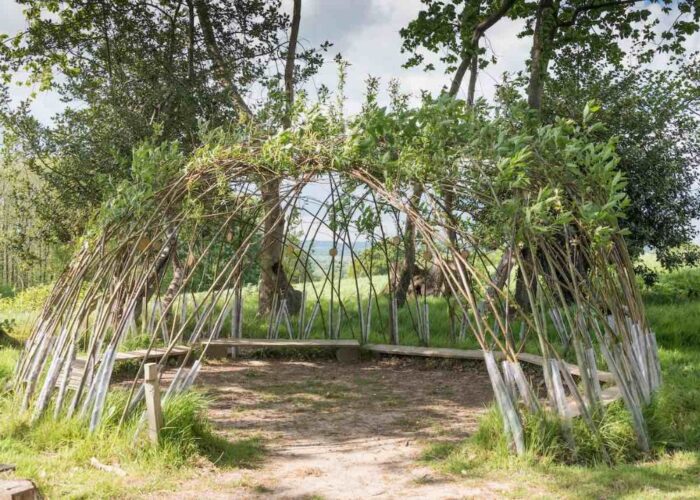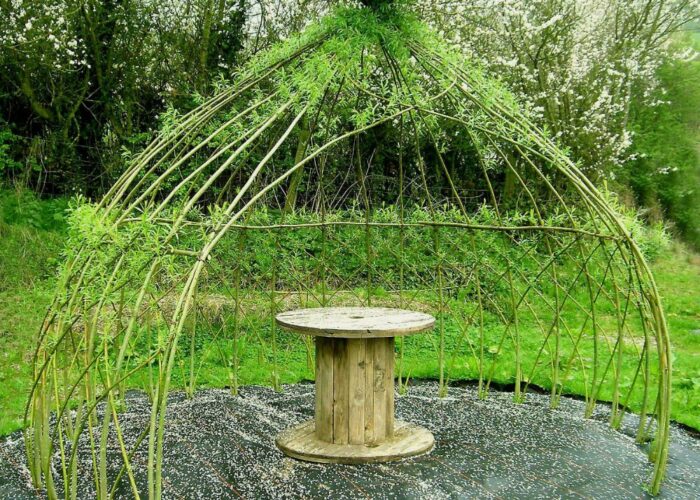A living willow structure is a green construction created by using willow branches to shape and connect with each other. The willow branches will grow and take root, forming a sustainable and visually appealing structure. Various shapes can be crafted from living willow structures, such as an arch, a flower gate, or a gazebo.
In this article, we will guide you on how to make a living willow structure, dome, arbor. Have a read!
Contents [hide]
- 1. How to make a living willow structure?
- Step 1: Choose a suitable location for your living willow structure
- Step 2: Design the desired shape for your living willow structure
- Step 3: Select suitable willow branches for your living willow structure
- Step 4: Dig small holes along the outline of the pattern
- Step 5: Plant the willow branches into the dug holes
- Step 6: Bend and securely tie the willow branches together
- Step 7: Care for and maintain your living willow structure
- 2. FAQs
- 3. Final thought
1. How to make a living willow structure?
A living willow structure is an artistic and romantic construction created by utilizing live willow branches to form various shapes. You can craft a willow structure by following these steps:
Step 1: Choose a suitable location for your living willow structure
It should receive adequate sunlight, have good soil, and be sheltered from strong winds or excessive water.

Step 2: Design the desired shape for your living willow structure
You can sketch it on paper or use strings to mark the pattern on the ground.
Step 3: Select suitable willow branches for your living willow structure
Opt for long, flexible branches with fewer side shoots. You can purchase branches from nurseries or harvest them from willow trees.
Step 4: Dig small holes along the outline of the pattern
The spacing between holes should be approximately 30 cm, with a depth of around 20 cm.
Step 5: Plant the willow branches into the dug holes
Ensuring they are firmly and deeply inserted to allow for rooting and growth. Leave about one-third of the length of the branches above the ground.

Step 6: Bend and securely tie the willow branches together
To create the desired shape. You can use string, wire, or clips to prevent the branches from slipping out.
Step 7: Care for and maintain your living willow structure
Regularly water, fertilize, and trim excess or dead branches. Check and repair any damaged or loose parts of your willow structure.
A living willow structure is a unique and vibrant creation, bringing beauty and a close connection to nature to your space. Try crafting your own structure based on your ideas and enjoy the creative process!
2. FAQs
2.1 What is a living willow structure?
A living willow structure is a construction created by taking young willow trees, planting them in the ground, and then training and pruning them above ground to form a specific shape. Some common types of living willow structures include fences, archways, domes, arbors, pergolas, igloo-shaped shelters, screens, windbreak fences, and play tunnels.
The characteristics of willow wood allow for the creation of various shapes and structures for artistic and/or practical purposes in your garden.
Living willow structures offer numerous benefits for both the environment and humans, such as erosion control, increased biodiversity, carbon absorption, and the creation of cool and engaging green spaces.
2.2 What is the best willow for willow structures?
Some common willow varieties for willow structures are Salix viminalis, Salix purpurea, and Salix alba. These types of willow are resilient to low temperatures, exhibit high durability, offer diverse colors, and come in sizes suitable for bending and tying.
However, there is no one-size-fits-all willow variety, as the choice depends on your intended use, design preferences, and budget. Consulting with willow experts is advisable to select the most suitable willow type for your specific willow structure.
2.3 How long does it take to grow a living willow structure?
The time it takes to grow a living willow structure depends on various factors, including the willow species, local climate, soil conditions, and care provided. In general, it typically takes one to three growing seasons for a willow structure to establish and develop. During this period, the willow branches planted in the ground will root, grow, and intertwine to form the desired shape.
It’s important to note that willows are known for their fast growth, and some structures may start to take shape within the first year. However, more complex or larger structures may require additional time for full maturation. Regular watering, proper maintenance, and suitable environmental conditions can contribute to faster and healthier growth of the living willow structure.
2.4 How do you maintain a willow dome?
To upkeep a willow arch, several essential steps should be undertaken. Regularly watering the willow branches promotes their robust growth and secure attachment to the arch frame.
Trimming any excess or overly extended branches not only ensures an aesthetically pleasing form for the arch but also prevents unruly growth. Periodic inspections are crucial to identify and repair any damage to the arch frame caused by weather conditions or pests.
Safeguarding the arch from potentially harmful animals, such as mice, squirrels, or birds, can be achieved through the installation of barriers or deterrent devices. Additionally, adding decorative accessories like lights, flowers, or fabric enhances the allure of the willow arch, transforming it into a captivating feature in your outdoor space.
3. Final thought
In conclusion, crafting a living willow structure offers not only a creative outlet but also a sustainable and visually captivating addition to any outdoor space. By following the steps outlined in this guide, individuals can create their own unique living willow structures, whether it be an arch, dome, or arbor.
The process involves careful selection of location, design, and willow branches, along with ongoing care and maintenance to ensure healthy growth and longevity. With the versatility of willow and its numerous environmental benefits, such as erosion control and increased biodiversity, living willow structures serve as a testament to the harmonious integration of nature and human ingenuity.
For any further questions, don’t hesitate to send us an email us at info@thanhcongcraft.com or message us at WhatsApp: +84967485411. Best regard!


